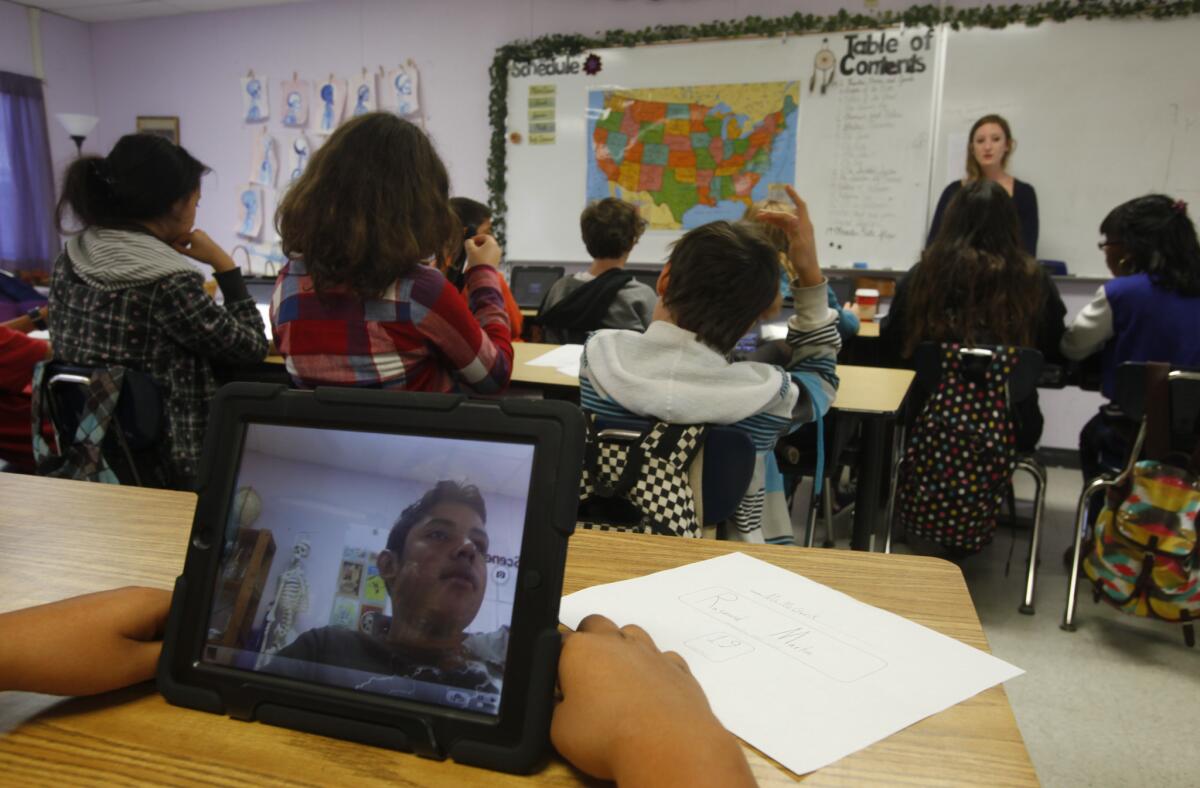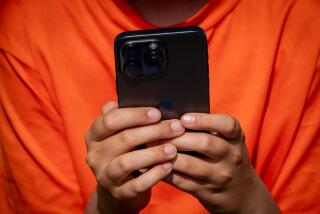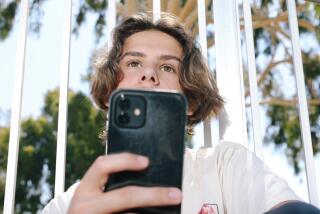iPad use out of sync with L.A. charter school’s philosophy

- Share via
The eighth-graders in Stephanie McGurk’s class at Ocean Charter School began a recent day as they usually do: reciting a verse celebrating nature. Next, they played scales on recorders as they sat in a classroom furnished with wood furniture, lamps, wicker baskets, artwork and plants.
Then McGurk did something incongruous in a school that avoids plastic toys, let alone technology: She handed each student an iPad.
By chance, Ocean Charter, a Westside school based on the Waldorf educational philosophy, became part of the much-debated $1-billion effort to provide an iPad to every student and teacher in the Los Angeles Unified School District.
As a charter school, Ocean is run independent of L.A. Unified. Still, under state law, charters are entitled to roughly equivalent learning conditions and L.A. Unified decided that charters operating on district property are eligible for iPads. The district selected Ocean because it uses classrooms on the campus of Westchester High, which was among the first 47 schools to receive the devices this fall.
And for Ocean, this created unique tensions. The school was caught between a philosophy that strictly limits technology and a school district determined to provide it.
Ocean asks parents to keep students away from technology and media on school nights. It also avoided computers, even for school work, until sixth grade.
A strict, private Waldorf school might not have even accepted the devices. For more than 100 years, Waldorf schools have emphasized child development over skill development.
Instead of plastic dolls with detailed faces, for example, young children in a Waldorf environment play with toys made of natural materials, such as wood, silk, wool and cotton -- that are unformed enough to stimulate the imagination. Schools encourage creative play and artistic expression; students often stay with the same teacher three years or more.
Some parents who subscribe to Waldorf methods don’t let their children use technology at all; others limit screen time.
As a public school, Ocean cannot follow all Waldorf beliefs and practices. It has eliminated religious references, for example. It’s also accepted annual standardized testing -- as well as the idea that the school will be accountable for academic results.
Still, a technological emphasis seems to cut against the grain.
Nearly every classroom has a garden as well as shelves of books, musical instruments and a wealth of art supplies. On a recent visit, fifth-graders were exploring mushrooms using their five senses.
Director Kristy Mack-Fett is aware that new state standardized tests will be given on computers and that new state learning standards require knowledge of technology. For those reasons, she’s grateful for the devices.
At the same time, parents and teachers have shared their serious concerns freely, although there’s been no rebellion.
“Most parents are plugged in,” said parent Lisa Cahill. “It’s not like they’re off the grid.” But until parents realized the younger students would only use iPads for testing, they were “a little freaked out.”
“I don’t want to be responsible for a $700 iPad,” said parent Tamara Haas, who questioned the expense and wisdom of the program.
Mack-Fett was discomfited by a promotional video showing a classroom of students plugged into tablets with ear buds.
“This technology shouldn’t replace a school community with people interacting in live situations and working through problems,” she said.
Nor was she impressed with students writing on the touch screens with their fingers; Ocean instructors teach printing, then cursive writing over three years.
“The physical act of writing is important, both print and cursive,” Mack-Fett said.
Ocean, which offers kindergarten through eighth grade, has needs beyond iPads. It lacks a permanent campus: The school’s 454 students are split between a rented church for the lower grades and space at Westchester for grades four through eight. In its corner of Westchester, the school’s only running water is in the student bathrooms.
In her class last week, McGurk explained to students how to turn on the devices and how to carry them safely -- hugging them to their chests, glass screen facing in. But it’s not as if most students are new to computers.
At home, Andre Hinton said he has a MacBook Air, two MacBook Pros, an iPod, an iPhone 5 and an iPad.
West Adler recognized that the device handed out was a newer model because it has a different charging cord.
“We have Garage Band,” he added excitedly, scanning the apps. “I want to try it.”
“Can we use the iPad today?”
“No,” McGurk told him.
At Ocean, students have learned word processing in sixth grade and online research in seventh. And they can use computers, as appropriate, for yearlong projects in eighth grade. Recently, one student built a computer, another a guitar and another researched the challenges around becoming a female FBI agent.
That format will continue, although students will learn how to use a keyboard earlier and take periodic exams to ensure they acquire necessary skills.
In contrast, L.A. schools Supt. John Deasy has bigger plans for the iPads in the nation’s second-largest school system. He hopes the devices -- which cost $768 each -- will deliver the curriculum for the district’s 560,000 students, starting with kindergarten. He sees the tablets offering a richer, more engaging experience tailored to each student, while also allowing for group work. He also wants low-income students to have the benefit of devices that their more affluent peers take for granted.
The effort to distribute the iPads to schools has encountered delays and other problems, including when more than 300 students at three high schools deleted security filters so they could surf the Web freely. The episode led to the devices being pulled from those campuses; students elsewhere now must keep them at school. On Tuesday, the Board of Education voted to slow the iPad distribution, reevaluate the contract and examine the academic benefits.
At Ocean, the teachers don’t intend to supplant creative, if low-tech, teaching strategies. In McGurk’s lessons on anatomy, students studied bone and muscle systems but she also brought the topic to life with tales about the Day of the Dead and about the Celtic origins of Halloween. Her students made sugar skulls and used watercolors to paint pictures of them, while her old-fashioned blackboard was covered with vibrantly colored chalk drawings of a skeleton band performing in a graveyard. A skeleton model stood upright in the classroom, and she engaged students with a game of bone bingo, which also served as review for a test.
Sixth-grade teacher Kit Olbris knows how to use computers -- she’s getting an online degree and emails parents -- but she’s not especially gung-ho on iPads.
“I suppose you could go out in the garden and take a picture of a flower with an iPad and then come in and draw it,” said Olbris, who’s been teaching at Waldorf schools since the mid-1980s. “But then you’re not in the garden experiencing the wind and sun playing off the flower.”
Olbris added: “Observing the sunset. Going out and looking at the night sky. Finding the pole star looking at the Big Dipper. You cannot get this in a Google search.”
More to Read
Sign up for Essential California
The most important California stories and recommendations in your inbox every morning.
You may occasionally receive promotional content from the Los Angeles Times.










